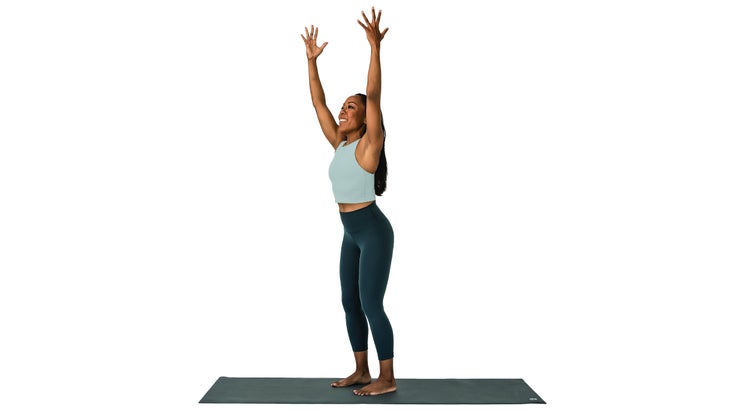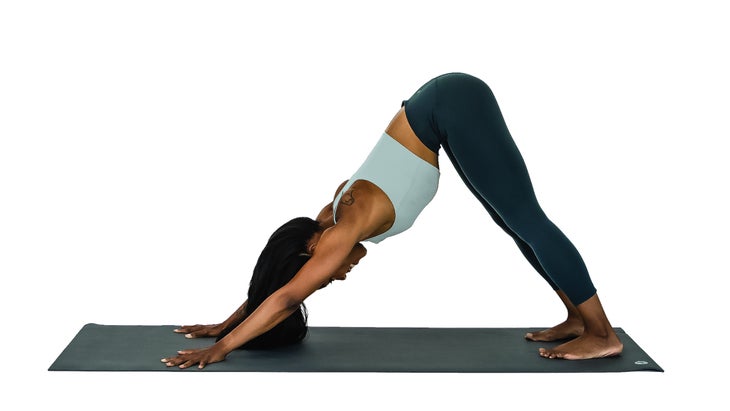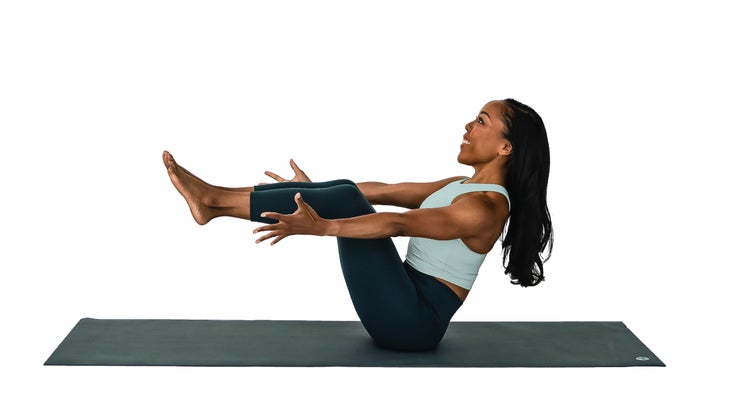Heading out the door? Read this article on the new Outside+ app available now on iOS devices for members! Download the app.
Breathwork is one of the standard components in a Kripalu session. Begin each of these energy-balancing breathing exercises from a stable, balanced, upright seat. You may want to start with several rounds of Dirga to settle the mind before trying one of the other pranayama practices. After you finish, sit quietly and observe sensations in the body.
If you want to add more movement to your breathwork, follow these pranayama exercises with the compassionate Kripalu sequence below.
See also: A Beginner’s Guide to Pranayama
Reunite with your breath

Dirga Pranayama (Three-Part Breath)
Inhale deeply through your nose, first expanding your belly, then your rib cage and chest. Exhale through your nose, guiding your breath out from the chest first, ribs second, and belly last. (Visualize your breath pouring into and out of the torso like water in a glass. Place your hands on your belly and rib cage to give yourself a connection to the practice.) Repeat for several rounds or several minutes.

Kapalabhati (Skull Shining Breath)
Inhale and pause. Contract your abdominals as you completely exhale out of your nose, drawing your navel in and up. Completely relax your belly and allow your breath to be vacuumed back in passively. Continue for multiple rounds at your own pace and intensity. When you’re ready to end, inhale deeply through your nose. Hold your breath for a moment, then exhale and come back to your natural breath.

Anuloma Viloma (Alternate-Nostril Breathing)
Rest your left hand on your knee in Gyan Mudra and bring your right hand into Vishnu Mudra—first and middle finger folded toward your palm; thumb, ring finger, and pinkie extended. Use your thumb to block off your right nostril. Inhale through your left nostril, and pause your breath for a few moments. Then block your left nostril with your ring finger and exhale out your right nostril. Inhale through the right, pause, then block your right nostril, and exhale out your left nostril. That’s one round. With each round, allow the inhalations, exhalations, and pauses to lengthen. End with an exhalation out of your left nostril.
A compassionate Kripalu Yoga sequence
Hold each of these postures for 5–10 breaths, noticing any thoughts or sensations that arise, and meeting them with curiosity and compassion. Invite more ease into any areas you notice tightening or gripping. After you exit each asana, pause for a few moments of stillness and feel the effects of the pose before moving on to the next posture or taking the pose on the other side.
The highest form of spiritual practice is self-observation without judgment. —Swami Kripalu

Tadasana (Mountain Pose)
Stand with your feet parallel and hip-distance apart. Stack your head, rib cage, and pelvis over your heels. Let your arms fall alongside your body. Make sure your pelvis is level. Inhale, and sweep your arms out to the sides and overhead in a wide V shape, with your palms facing each other. Exhale, and soften your shoulders down. Inhale again, pressing down through your feet, and lengthening through the crown of your head. Exhale as you lower your arms.

Utkatasana (Chair Pose)
From Mountain Pose, exhale, and bend your knees and lower your hips back and down into what Kripalu teachers call Standing Squat. Inhale as you raise your arms up to shoulder height, lengthening your spine and lifting your chest. Relax your shoulders away from your ears. To exit the pose, straighten your knees and lower your arms by your sides.

Virabhadrasana I, Variation (Warrior Pose I)
From Mountain, inhale, and step your left leg back a leg’s length to land on the ball of your left foot with your leg straight. Exhale, and bend your right knee to lower your hips, keeping them square and level. Inhale, and sweep your arms overhead into a wide V shape. Exhale, lower your hands to your hips, slightly bend your back knee, and step forward into Mountain.

Trikonasana (Triangle Pose)
From Mountain, turn to face the long side of the mat. Step into a wide-legged stance with your feet about a leg’s length apart and parallel. Place your hands on your hips. Inhale as you turn your right toes to face the front of your mat, and raise your arms to the side. Exhale, and press your right hipbone down as you draw your left hip to the left, toward the back of your mat.
Folding deeply at your right hip crease, reach to the right, lengthening your upper body out over the right leg. Open your shoulders to stack your left shoulder over the right, and extend your left arm toward the ceiling as you reach your right arm toward the floor, perching your fingertips on your thigh, shin, or a block placed outside of your right foot. Gaze forward or look up. Inhale, and draw yourself back upright. Return to Mountain. Repeat on the other side.

Breath of Joy
Stand in Mountain with your knees slightly bent. Sip in one-third of a full breath through your nose as you straighten your knees and sweep your arms forward to shoulder height. Hold your breath as you bend your knees and drop your arms back by your sides. Sip in a second third of a breath as you again straighten your knees and sweep your arms out to the sides and up to shoulder height. Hold your breath, bend your knees, and drop your arms back by your sides. Sip in the last third of breath in as you straighten your knees and sweep your arms forward and up toward the ceiling.
Bend your knees deeply, fold forward over your legs, and sweep your arms forward, down, and slightly behind you as you exhale all the breath out of your mouth with a gentle “ha.” Inhale, and return to standing. Practice this at your own pace for 5–10 more rounds, folding forward as much or as little as you like. Exhale completely before beginning the next inhalation.

Adho Mukha Svanasana (Downward-Facing Dog Pose)
Come into Tabletop. Tuck your toes under. Inhale, and lift your knees off the floor. Exhale, and send your hips up and back to create an inverted V shape. Move your belly closer to your thighs. Keep your spine long as you straighten your legs. (Slightly bend your knees if needed.) Let your head hang between your upper arms. To release, bend your knees and lower yourself to Tabletop.

Paripurna Navasana (Full Boat Pose)
Sit upright with your knees bent, feet on the floor hip-width apart. Hold the backs of your thighs. Lean back slightly and find balance between your sitting bones and tailbone. Inhale, and slowly lift your shins until they are parallel to the floor. Keep your spine long and chest lifted as you take steady, slow breaths. Try reaching your arms forward at shoulder height and/or straightening your knees for the full expression of what is called Upward Boat Pose in Kripalu Yoga. Release on an exhalation as you lower your feet to the floor.

Setu Bandha Sarvangasana (Bridge Pose)
Lie on your back with your arms alongside your body, palms facing down. Keep your knees bent and feet on the floor, hip-width apart and parallel, heels a few inches away from your buttocks. Press down with your hands and feet, then inhale and lift your hips. Keep your spine straight. Lift your sternum up and arch your back as you stretch your tailbone toward your knees. Keep your arms by your sides or walk them underneath you and interlace your fingers. To release, place your arms by your sides and lower your hips.

Matsyendrasana (Lord of the Fishes Pose)
Sit up tall in Dandasana (Staff Pose). Bend your right knee and bring your foot to the floor outside your left leg anywhere between your knee and groin. Hold your right knee with your left hand or wrap your left arm around your right leg for stability. Bring your right hand to the floor behind you. Inhale, and lengthen your spine. Exhale, and rotate your torso to the right. To release, inhale, unwind your arms, and re-center your torso. Repeat on the other side.

Savasana (Corpse Pose)
Gather any props you might want for padding and support. Lie on your back, and separate your legs a little wider than hip-distance apart. Place your arms slightly away from the sides of your body. Palms can be face up or down. Adjust your shoulders, hips, and head until you are supported and at ease. Let go of the need to do anything else for now. Just practice being present. Stay here 3–10 minutes.
See also: 5 Calming Yoga Poses You Can Do in 5 Minutes
Michelle Dalbec, E-RYT 500, is a lead faculty member of the Kripalu Schools, a RISETM facilitator, and co-creator of Unified Body Yoga.
Sadia Bruce, E-RYT 500 (model), is a Kripalu faculty member, writer, documentarian, and therapeutic movement specialist.